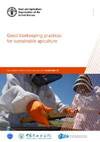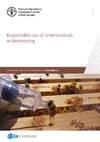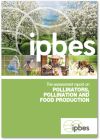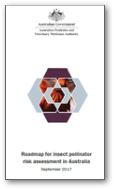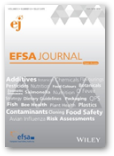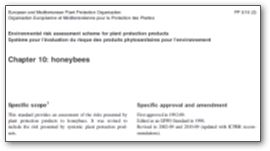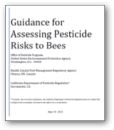Selected resources for the Seminar
Many reports, articles and other publications are available that are relevant for the topics discussed during the Seminar. Below is a small selection of resources that have a direct bearing on the Seminar.
- Studies conducted for the seminar
- Reports published by FAO
- External publications
1. Studies conducted for the seminar
Review of existing legislation to protect pollinators from pesticides in selected countries (2022)
Study conducted by Bill Garthwaite, International Legal Expert for the FAO Development Law Service, on current legislation to protect pollinators from pesticides. It involves a review of legal instruments in selected African, Caribbean and Pacific countries, as well as in several reference countries having established regulatory frameworks.
The study can be downloaded here
Review of approaches to the environmental risk assessment (ERA) for bees and other pollinators (2022)
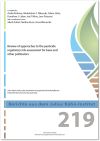 Study conducted by the Institute for Bee Protection of the Julius Kühn Institute, in Germany, as a contribution to the Global Seminar. The review assesses current pollinator risk assessment approaches in several reference countries having established regulatory frameworks. It also evaluates to what extent pollinator hazard and risk assessment is conducted in selected African, Caribbean and Pacific countries, provides suggestions on best to strengthen this.
Study conducted by the Institute for Bee Protection of the Julius Kühn Institute, in Germany, as a contribution to the Global Seminar. The review assesses current pollinator risk assessment approaches in several reference countries having established regulatory frameworks. It also evaluates to what extent pollinator hazard and risk assessment is conducted in selected African, Caribbean and Pacific countries, provides suggestions on best to strengthen this.
The report can be downloaded here
2. Reports published by FAO
Beekeeping and pesticides
Good beekeeping practices for sustainable apiculture (2021)
These guidelines aim to provide useful information and suggestions for a sustainable management of bees around the world, which can then be applied to project development and implementation.
Responsible use of antimicrobials in beekeeping (2021)
These FAO guidelines focus on responsible use of antimicrobials in sustainable apiculture. Prudent and limited use of antimicrobials in beekeeping benefits the quality of bee products, while also slowing development of antimicrobial resistance, which is a widespread issue affecting multiple sectors.
Risks of pesticides to pollinators
Pollinator safety in agriculture (2014)
This publication provides guidance on the natural history of wild bees and their potential exposure to pesticides. It is based on a series of presentations made at a session about “exploring pesticide effects on non-Apis bees”, at the 10th international symposium on pollination, convened by the international Commission on plant-bee relations, in Mexico, 27-30 June, 2011.
Agreed quantitative risk assessment procedures for wild bees, or honey bees in (sub-) tropical cropping systems are not available. Instead, generic risk profiles were developed for crops in Brazil, Kenya and the Netherlands, which provide a structured assessment of potential risks from pesticides to bees while making explicit any data and knowledge gaps.
Socio-economic valuation of pollination services
Guidelines for the economic valuation of pollination services at national a scale (2009)
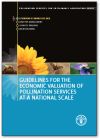
The negative impact of the loss of pollinators is strongly felt in agricultural biodiversity. this document explains the use of a tool for assessing national vulnerabilities to pollinator declines.
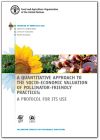
This book presents a guidance and protocol for determining the socio-economic value of pollinator-friendly versus -unfriendly practices. Value is expressed in monetary and non-monetary terms, and both are integrated in this approach, which is applicable at the farm but also the landscape level.
3. External publications
In this section, links are provided to relevant resources about pesticides and pollinators which are published outside the Food and Agriculture Organization of the United Nations (FAO).
Impact of pesticides on pollinators – reviews
The assessment report on pollinators, pollination and food production (2016)
Intergovernmental Science-Policy Platform on Biodiversity and Ecosystem Services (IPBES).
Note: Chapter 2.3 reviews the effects of pesticides on pollinators. Chapter 6.4.2 discusses risk mitigation options to reduce pesticide impact on pollinators.
Policies for pesticide risk reduction
National policies, strategies and action plans to promote and protect pollinators tend to have specific sections or activities which aim to reduce risks posed by pesticides.
FAO has compiled several of these national initiatives, as part of its Global Action on Pollination Services for Sustainable Agriculture.
Pesticide risk assessment guidance for pollinators
Australia
Roadmap for insect pollinator risk assessment in Australia (2017). Australian Pesticides and Veterinary Medicines Authority (APVMA)
Brazil
Manual de avaliação de risco ambiental de agrotóxicos para abelhas (2020) Instituto Brasileiro do Meio Ambiente e dos Recursos Naturais Renováveis (IBAMA)
Europe
EFSA Guidance Document on the risk assessment of plant protection products on bees (2013). European Food Safety Authority (EFSA)
Note: this guidance document is currently under revision. It has not been formally adopted in the European Union, but is applied (in part) by several national pesticide regulatory authorities in Europe
Environmental risk assessment scheme for plant protection products. Chapter 10 – honeybees (2010). European and Mediterranean Plant Protection Organization (EPPO)
Note: Although this guidance document has been discontinued from the EPPO web site, due to the publication of EU guidance, it is still considered a useful introductory risk assessment approach for honey bees.
North America
Guidance for assessing pesticide risks to bees (2016)
US Environmental Protection Agency (US EPA), Health Canada Pest Management Regulatory Agency (PMRA), California Department of Pesticide Regulation (CDPR).
Note: also available in Spanish



